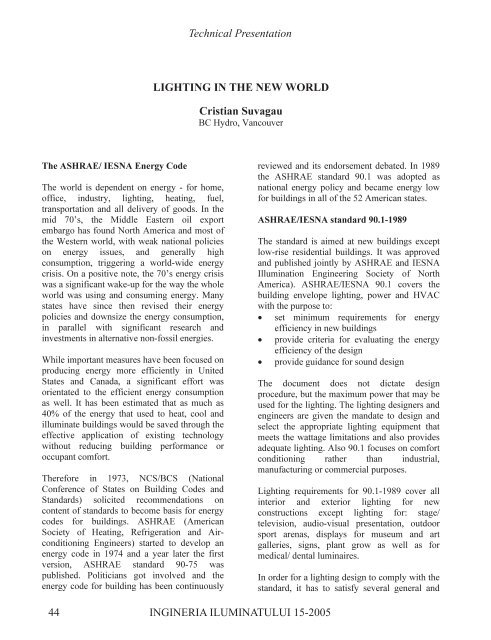Ingineria Iluminatului - Journal of Lighting Engineering - Prof. Florin ...
Ingineria Iluminatului - Journal of Lighting Engineering - Prof. Florin ...
Ingineria Iluminatului - Journal of Lighting Engineering - Prof. Florin ...
Create successful ePaper yourself
Turn your PDF publications into a flip-book with our unique Google optimized e-Paper software.
The ASHRAE/ IESNA Energy Code<br />
The world is dependent on energy - for home,<br />
<strong>of</strong>fice, industry, lighting, heating, fuel,<br />
transportation and all delivery <strong>of</strong> goods. In the<br />
mid 70’s, the Middle Eastern oil export<br />
embargo has found North America and most <strong>of</strong><br />
the Western world, with weak national policies<br />
on energy issues, and generally high<br />
consumption, triggering a world-wide energy<br />
crisis. On a positive note, the 70’s energy crisis<br />
was a significant wake-up for the way the whole<br />
world was using and consuming energy. Many<br />
states have since then revised their energy<br />
policies and downsize the energy consumption,<br />
in parallel with significant research and<br />
investments in alternative non-fossil energies.<br />
While important measures have been focused on<br />
producing energy more efficiently in United<br />
States and Canada, a significant effort was<br />
orientated to the efficient energy consumption<br />
as well. It has been estimated that as much as<br />
40% <strong>of</strong> the energy that used to heat, cool and<br />
illuminate buildings would be saved through the<br />
effective application <strong>of</strong> existing technology<br />
without reducing building performance or<br />
occupant comfort.<br />
Therefore in 1973, NCS/BCS (National<br />
Conference <strong>of</strong> States on Building Codes and<br />
Standards) solicited recommendations on<br />
content <strong>of</strong> standards to become basis for energy<br />
codes for buildings. ASHRAE (American<br />
Society <strong>of</strong> Heating, Refrigeration and Airconditioning<br />
Engineers) started to develop an<br />
energy code in 1974 and a year later the first<br />
version, ASHRAE standard 90-75 was<br />
published. Politicians got involved and the<br />
energy code for building has been continuously<br />
44<br />
Technical Presentation<br />
LIGHTING IN THE NEW WORLD<br />
Cristian Suvagau<br />
BC Hydro, Vancouver<br />
INGINERIA ILUMINATULUI 15-2005<br />
reviewed and its endorsement debated. In 1989<br />
the ASHRAE standard 90.1 was adopted as<br />
national energy policy and became energy low<br />
for buildings in all <strong>of</strong> the 52 American states.<br />
ASHRAE/IESNA standard 90.1-1989<br />
The standard is aimed at new buildings except<br />
low-rise residential buildings. It was approved<br />
and published jointly by ASHRAE and IESNA<br />
Illumination <strong>Engineering</strong> Society <strong>of</strong> North<br />
America). ASHRAE/IESNA 90.1 covers the<br />
building envelope lighting, power and HVAC<br />
with the purpose to:<br />
• set minimum requirements for energy<br />
efficiency in new buildings<br />
• provide criteria for evaluating the energy<br />
efficiency <strong>of</strong> the design<br />
• provide guidance for sound design<br />
The document does not dictate design<br />
procedure, but the maximum power that may be<br />
used for the lighting. The lighting designers and<br />
engineers are given the mandate to design and<br />
select the appropriate lighting equipment that<br />
meets the wattage limitations and also provides<br />
adequate lighting. Also 90.1 focuses on comfort<br />
conditioning rather than industrial,<br />
manufacturing or commercial purposes.<br />
<strong>Lighting</strong> requirements for 90.1-1989 cover all<br />
interior and exterior lighting for new<br />
constructions except lighting for: stage/<br />
television, audio-visual presentation, outdoor<br />
sport arenas, displays for museum and art<br />
galleries, signs, plant grow as well as for<br />
medical/ dental luminaires.<br />
In order for a lighting design to comply with the<br />
standard, it has to satisfy several general and
















